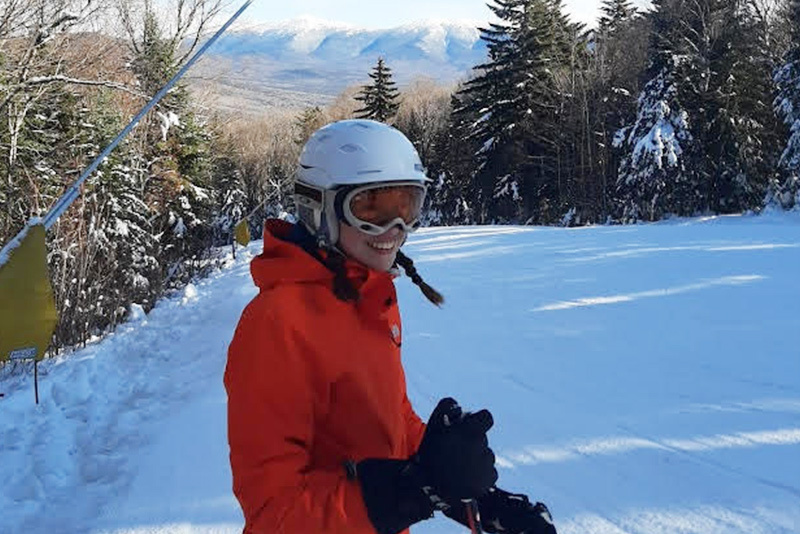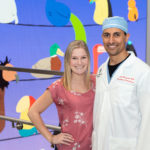No longer just ‘getting through the day’: Addressing Lucie’s chronic pain

Lucie Robert had always been an engaged and active kid: At just 10 years old, she loved Nordic skiing, dancing, and playing the cello. Yet she was also prone to injury, sometimes on crutches because of minor twists and sprains. Even after a series of minor dislocations led to a diagnosis of Ehlers-Danlos syndrome (EDS) — a group of disorders that affect the connective tissue — she kept moving.
As the years passed, however, Lucie went from occasionally needing crutches to relying on finger, wrist, and knee braces for many of the activities she loved. By age 14, she was dislocating her shoulder just by rolling out of bed in the morning. Then the EDS began to affect her neck. Now in chronic pain, she could no longer just “work through” it.

When pain defines your life
Because Lucie’s physicians had advised her to rest and avoid playing sports to protect her neck, she started wearing a neck brace, could only sleep in a recliner, and eventually stopped attending school regularly. And the whole family felt the effects of her pain. “Lucie’s condition is invisible — she looks fine and strong,” says her mother, Margot. “But she was in so much pain. Our lives started to be defined by it.”
That began to change when the Roberts learned about the Pain Treatment Center at Boston Children’s Hospital, which quickly referred them to the Pediatric Pain Rehabilitation Center (PPRC). “We finally felt like we weren’t alone,” says Margot.

Doing the impossible
An intensive day treatment rehabilitation program for kids and teens with chronic pain, the PPRC seemed daunting at first. “We didn’t think Lucie could even be out of bed for eight hours, let alone be that active,” says Margot. “We all thought, ‘No way is this possible.’”
But the rigorous multidisciplinary program — which includes regular daily sessions of physical therapy, occupational therapy, recreational therapy, psychological therapy, and more — proved to be the opposite. During her five weeks at the PPRC, Lucie found that not only was she able to keep up with the program, but she could do so safely by setting daily goals and learning strategies to address her pain.

Dreams of the future
A year later, Lucie has been able to maintain the progress she made at the PPRC. Now 16, she still uses the same strategies she learned there to manage her pain, such staying active through yoga and finding healthy forms of distraction, like cooking. In fact, when making choices, she often asks herself if PPRC staff — like psychologists Caitlin Conroy and Allison Smith and occupational therapist Gabrielle Bryant — would approve.
Getting through the school day is easier, too, thanks in part to a supportive administration and one of the PPRC’s psychologists. “Caitlin helped educate Lucie’s teachers about chronic pain and the need for her to take breaks to manage it,” says Margo. “Now, she hasn’t missed school in a year.”
Learning how to manage pain has helped Lucie get back to some of the activities she loves — and to try new ones. In addition to skiing, swimming, and volunteering with preschoolers, she’s thinking about hiking the Appalachian Trail. “A year ago, we were talking about shopping for wheelchairs,” says Margot. “Now, it’s not just about getting through the day. She has hopes and dreams again.”
Family-centered care
At the PPRC, children and teens aren’t the only patients. The innovative program includes parent and family involvement, in the form of family therapy, caregiver education, and support groups. The goal: to help kids transfer the skills they’ve learned back to their home life.
It’s an aspect of care that Margot and her husband, Paul have found especially beneficial. “The PPRC has helped us understand our roles as parents — how we can support Lucie with healthy distraction strategies rather than just trying to protect her from the pain,” she explains. That even includes rethinking the way the family discusses pain, shifting the conversation from asking Lucie how she’s feeling to what she wants to do that day.
The inclusion of caregivers in the program has also provided the Roberts with necessary support. “You really develop a community of people who have had similar experiences parenting children with chronic pain,” say Margot. “Until I was in a room with other parents, I had never really felt that other people ‘got it.’ Now, I finally feel heard.”
Learn more about the Pediatric Pain Rehabilitation Center.
Related Posts :
-

For Kayla, post-surgical pain relief supports a lifetime of care
At 24, Kayla Regan is old enough to be the mother of some of her fellow patients at Boston Children’s ...
-

Get answers about your child's chronic pain
[smartslider3 slider="8"]
-

Interventional pain techniques bring Sadie relief
It’s hard for Sadie Doherty and her parents to remember a time when she hasn’t been in pain. ...
-

‘Everything fell into place’: Innovative POEM procedure lets Peyton eat without pain
Peyton Reed, 14, is a typical teenage boy: He enjoys tennis, video games — and food. So when eating became so painful ...





